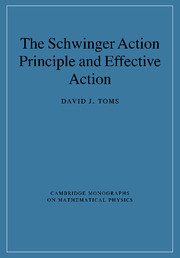Book contents
- Frontmatter
- Contents
- Preface
- 1 Action principle in classical mechanics
- 2 Action principle in classical field theory
- 3 Action principle in quantum theory
- 4 The effective action
- 5 Quantum statistical mechanics
- 6 Effective action at finite temperature
- 7 Further applications of the Schwinger action principle
- 8 General definition of the effective action
- Appendix 1 Mathematical appendices
- Appendix 2 Review of special relativity
- Appendix 3 Interaction picture
- Bibliography
- Index
3 - Action principle in quantum theory
Published online by Cambridge University Press: 27 October 2009
- Frontmatter
- Contents
- Preface
- 1 Action principle in classical mechanics
- 2 Action principle in classical field theory
- 3 Action principle in quantum theory
- 4 The effective action
- 5 Quantum statistical mechanics
- 6 Effective action at finite temperature
- 7 Further applications of the Schwinger action principle
- 8 General definition of the effective action
- Appendix 1 Mathematical appendices
- Appendix 2 Review of special relativity
- Appendix 3 Interaction picture
- Bibliography
- Index
Summary
States and observables
Bras, kets, and operators
There are at least two fundamental assumptions made in classical physics which do not apply in quantum physics. These two assumptions concern the types of measurements we can perform on a given system. The first assumption made is that it is possible, at least in principle, to perform a measurement on a given system in a way in which the interaction between the system being studied and the measuring apparatus can be made as small as we like. Because the act of measurement will disturb the system in some way, it is assumed that we can compensate for this disturbance to minimize the interaction. For example, if we look visually at an object by illuminating it with light, the illumination caused by the light leaving the light source and striking the object before being reflected to our eyes will impart some momentum to the object. Given the wavelength of light used we can always (in classical physics) work out what momentum is imparted, and we can compensate for this change in momentum by applying an appropriate force to the object to counteract this change. The second assumption made in classical physics is that there are no restrictions on what measurements we can make on a system either in type or in accuracy.
Both assumptions can break down when we consider systems which must be described by quantum mechanics.
- Type
- Chapter
- Information
- The Schwinger Action Principle and Effective Action , pp. 100 - 168Publisher: Cambridge University PressPrint publication year: 2007



